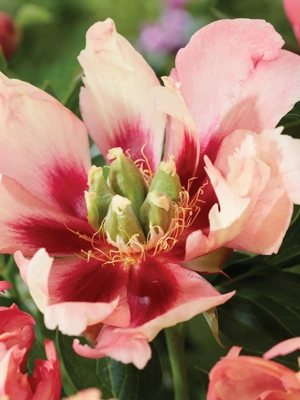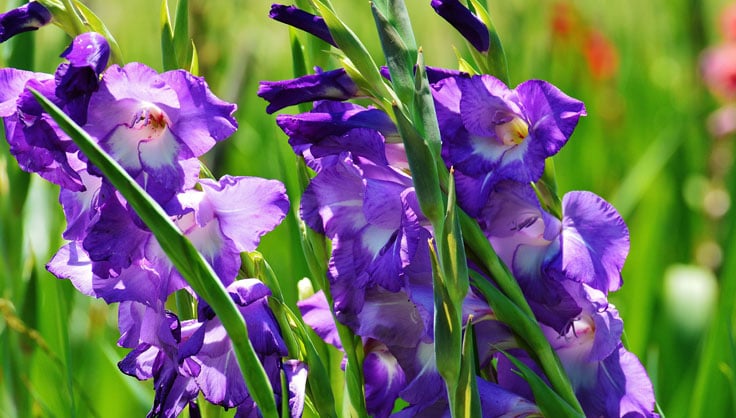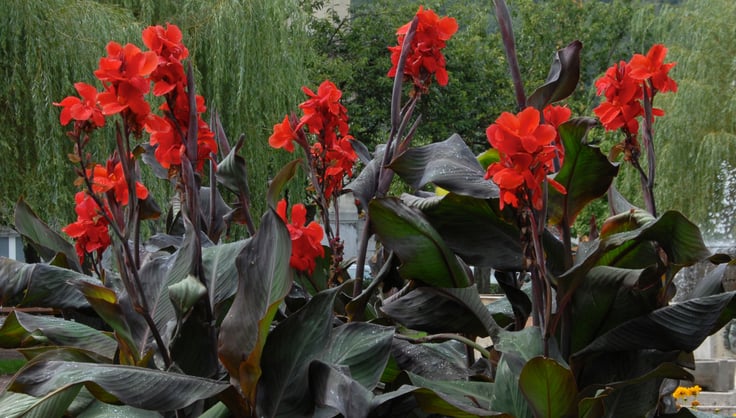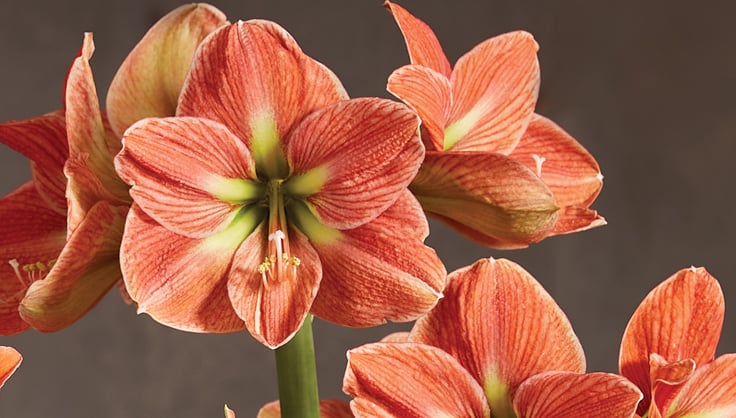How To Grow Peonies
How to plant and grow peonies
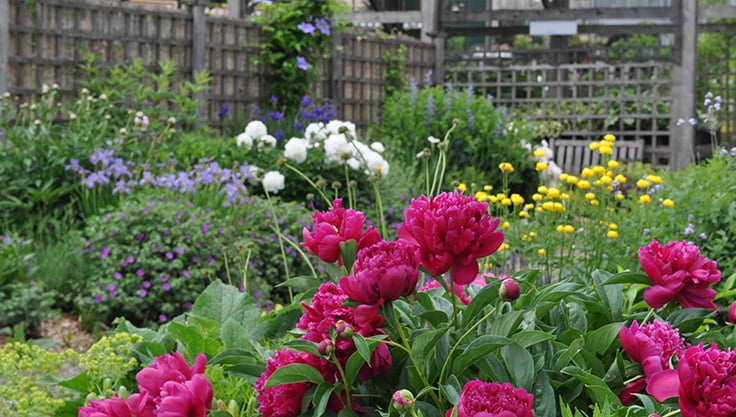 Magenta peonies in the foreground, and white ones further back, anchor this perennial bed in early summer. All photos by Suzanne DeJohn
Magenta peonies in the foreground, and white ones further back, anchor this perennial bed in early summer. All photos by Suzanne DeJohnPeonies are one of the best-known and most dearly loved perennials. This is hardly surprising considering their sumptuous beauty and fragrance, trouble-free nature, and longevity. Peonies also thrive almost anywhere in the country. Many varieties can even survive a zone 2 winter (that's a low of -50 degrees F).
If a peony is well situated and happy, it may bloom for 100 years or more with little or no attention. This means it's worth spending some time up front, choosing the right planting location and preparing the soil. That said, there are many stories about forgotten peony plants found blooming in the woods against old cellar holes. But like all plants, peonies will be healthier, more vigorous and more floriferous if they have ideal growing conditions.
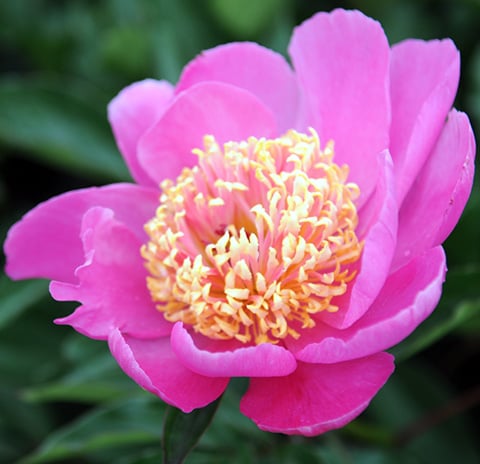 When choosing peonies, give special consideration to the "singles", which are fragrant and gorgeous, but don't require as much staking.
When choosing peonies, give special consideration to the "singles", which are fragrant and gorgeous, but don't require as much staking.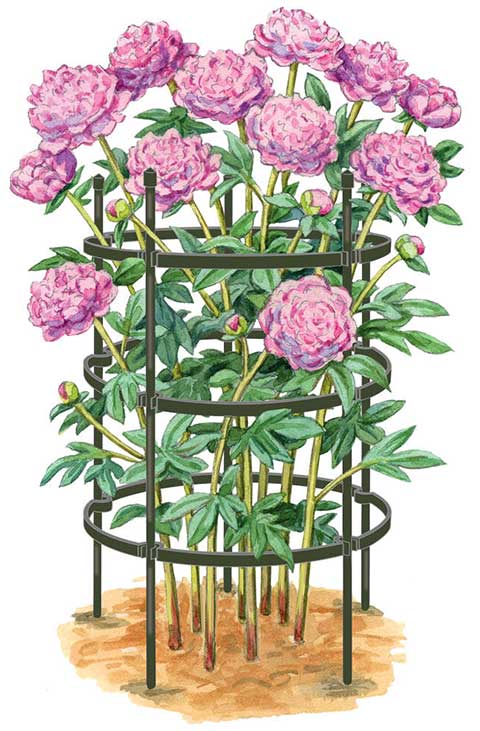 With super-sturdy Titan Peony Supports, you can set the rings to any height and raise them as peonies grow.
With super-sturdy Titan Peony Supports, you can set the rings to any height and raise them as peonies grow.Where to Plant Peonies
Peonies grow happily in zones 3-8. Pair these early summer stunners with irises, Baptisia, Delphinium, hydrangeas, and flowering bulbs like allium. Peonies look gorgeous in cottage-style gardens, foundation borders, and
- Peonies prefer full sun (at least 6 hours per day) — those growing at the warmest end of their range (zone 8) will appreciate some afternoon shade.
- Peonies like fertile, rich, well-drained soil. Think lots of nutrients but no heavy, soggy clay. If you have poor soil, consider growing your peony in a raised bed, where it will get maximum drainage!
- Space peonies about 3-4 feet apart to encourage good air circulation amongst plants and leaves.
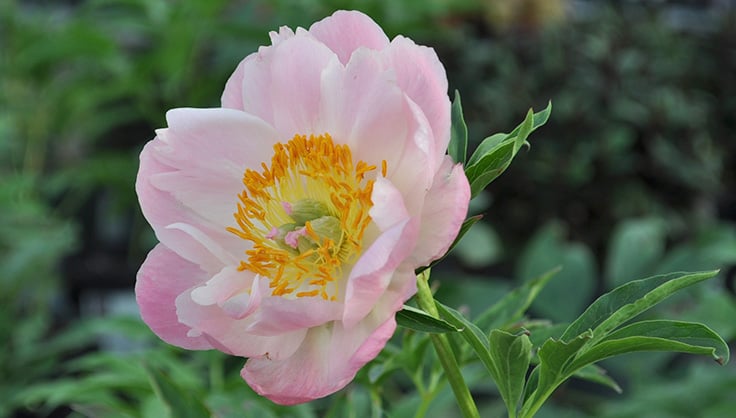 Abalone Pearl peony is a stunning semi-double variety with soft pink-peach petals contrasting with vibrant orange anthers.
Abalone Pearl peony is a stunning semi-double variety with soft pink-peach petals contrasting with vibrant orange anthers.How to Plant Peonies
Plant peonies in the fall when the plants are dormant. Get peonies settled in to their planting holes about 4-6 weeks before a deep freeze hits your region.
To plant a bareroot peony:
- Dig the soil to a depth of 12-18". Use a garden fork to loosen the sides of the planting hole as well.
- Add a shovelful of compost and a handful of an all-purpose, organic, granular fertilizer, to the bottom of the hole and then add a shovelful of the original soil. Build up a "cone" of this amended soil inside the planting hole and then position the peony root on top of the cone with its roots hanging down the sides.
- It is very important that the "eyes", or growth nodes, located near the base of the old stem, end up no more than 2" below the soil surface. If the peony root is positioned deeper than this, the plant may grow well, but it will produce few if any blooms.
- Backfill the hole halfway with native soil, then water deeply to help fill in any air pockets.
- Finish backfilling the hole with soil
To plant a nursery grown peony:
- Container-grown plants can be planted similarly. Just dig a hole that's twice as wide as the root ball but no deeper.
- Amend the soil as above.
- When planting, make sure the soil surface in the pot is at grade when the new plant is in the ground.
- As above, backfill halfway with native soil, water deeply, then finish backfilling.
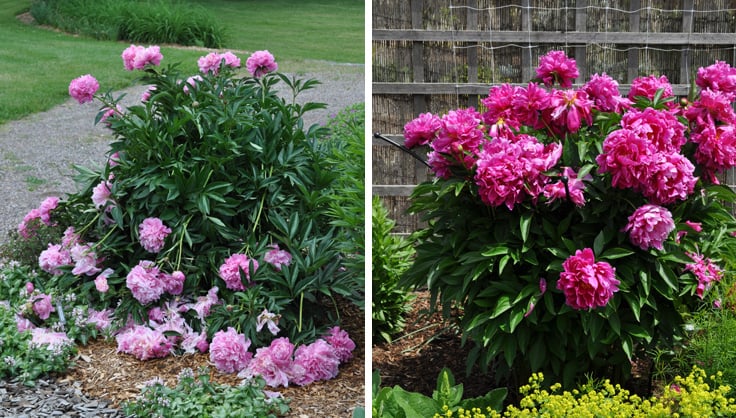 At left, gorgeous blooms have toppeled under their own weight. At right, a peony supported by an Essex Plant Support, which was installed in early spring so the foliage and flower stems could grow up through the support rings.
At left, gorgeous blooms have toppeled under their own weight. At right, a peony supported by an Essex Plant Support, which was installed in early spring so the foliage and flower stems could grow up through the support rings.Supporting Peony Plants
Depending on the variety and the growing conditions, you'll probably want to provide your peonies with some support when the flowers are in bloom. This is especially true for the double or "bomb"-style blossoms, which can become waterlogged and very heavy once flowers start opening. The supports should be positioned early in the growing season, before the plants get more than a few inches high. Once the plant has filled out, and especially when it's in bloom, it is nearly impossible to set up an effective support system.
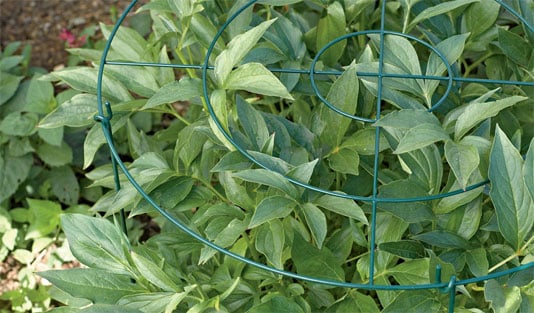 Grow-Through Supports are perfect for peonies. Set them in place in early spring so stems can grow through the grid.
Grow-Through Supports are perfect for peonies. Set them in place in early spring so stems can grow through the grid.Caring For Peony Plants
Peonies rarely bloom the first year after planting. It often takes three years before you see an abundant display of flowers. But once the plants do start blooming, you can look forward to a lifetime of beautiful flowers.
Feed annually: A yearly top-dressing of compost is all a peony requires for good health. If you mulch your flower beds, be sure to keep the mulch away from the base your peonies. If the base is covered with mulch, the plant reacts as if it has been planted too deep, and will produce few, if any, flowers.
Watch for fungus: Like other fungal diseases, botrytis is present in most soils. It usually only becomes a problem if the plant is weak, the weather is unusually cool and wet, or if there are other infected plants nearby. Signs of botrytis are blackened buds and stems, and sometimes rotting at the base of the plant. Cut off and dispose of any affected areas (put this material in the trash, not in your compost pile). The best strategy for botrytis problems is prevention, and that goes back to proper planting.
Divide occasionally: Peony plants rarely need dividing. If a clump becomes too large for a given space, or you wish to share some of the plant with a friend, fall is the ideal time for dividing. Cut back the foliage and carefully lift the entire plant out of the ground. Use a sharp knife to cut apart some of the plant, making sure to create generous clumps of roots with at least three to five eyes per clump. Reposition the original plant back in the hole, taking care not to break off any of the relatively brittle roots or leave large pockets of air in the planting hole. Water until you are sure the moisture has reached the bottom of the hole and that the soil has settled around the roots. Plants that have been divided in the fall may not bloom the following spring, but will return to normal the next season.
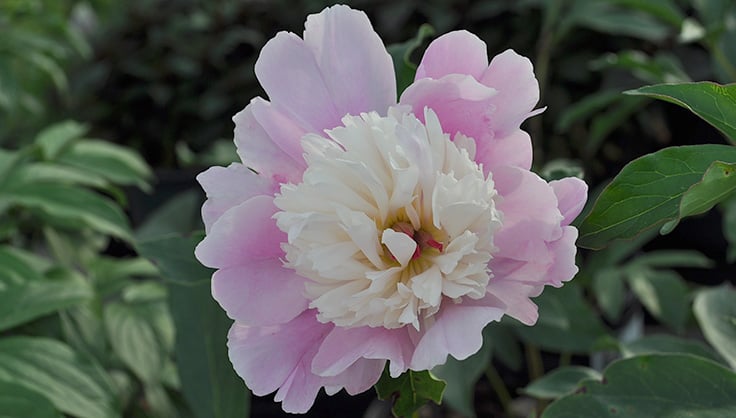 Bowl of Beauty peony's puffy white center contrasts nicely with the pink to magenta outer petals.
Bowl of Beauty peony's puffy white center contrasts nicely with the pink to magenta outer petals.Types of Peonies
According to the American Peony Society, there are 6 different recognized forms of peonies: Single, Japanese, Anemone, Semi-double, Bomb and Full double. Across those 6 different forms, there are hundreds of varieties, from heirloom favorites that have been enjoyed for centuries, to exciting new standouts in different colors (magenta, peach, coral, yellow) with different bloom times. You might also want to try your hand at growing tree peonies, which bloom earlier than herbaceous peonies, have larger blossoms and can grow up to 6 feet tall.
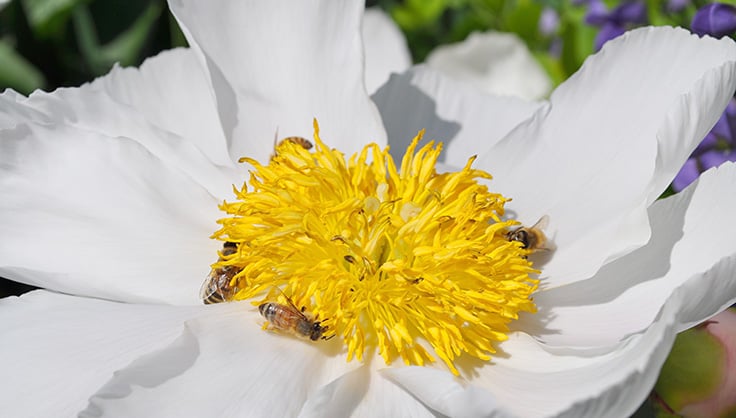 Single varieties, with just one or two rows of petals, are best for attracting pollinators.
Single varieties, with just one or two rows of petals, are best for attracting pollinators.Frequently Asked Questions: Growing Peonies
Why aren't my peonies blooming?
Failure to bloom is usually caused by two things: improper planting and/or insufficient light. When planting peonies, make sure to plant the eyes (the point at which new growth emerges) no more than two inches deep. Also make sure your plants get plenty of sun — 6 or more hours a day. If they're planted in a shady site, they will not flower well — if at all.
Also note that newly planted peonies usually don't flower the first year, which is spent developing a good root system and foliage. By the second spring after planting, you should see your first blooms.
What are tree peonies?
Although tree peonies are related to regular (herbaceous) peonies, they are much larger, reaching up to 6 feet. Their form is actually more like a shrub than a tree. In colder zones, they will not grow as tall — 3 or 4 feet is typical. Plants bloom just before the regular peonies; flowers are equally fragrant.
Can peonies be divided?
Yes. Unlike most perennials, peonies rarely need to be divided. The only reason to do it is to get more plants — or share them with friends. It's best done in the fall. Dig up the clump and use a sharp tool to divide it into sections, keeping three to five eyes in each division. Be sure to water the transplants thoroughly, unless you get plenty of rainfall. Keep in mind that divisions (and transplants) might not begin blooming again for two or three years.
Ants are crawling all over my peony buds. Are they going to eat the flowers?
No. These insects are merely enjoying the sugary syrup produced by the buds and are doing no harm to the plant.
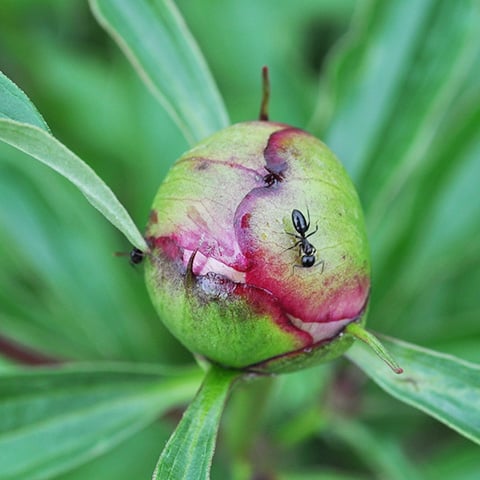 Peony bud with ants crawling on it.
Peony bud with ants crawling on it.The foliage on my peony has blackened and wilted. What can I do?
Peonies suffer from very few pest and disease problems. Nevertheless, they sometimes get fungal diseases, such as botrytis blight, which you describe. Other similar problems include blackened and/or rotten stems, withered buds, gray mold near the base of the plant. In all cases, remove and destroy the infected plant parts. Make sure the plants aren't getting overwatered; avoid sites with poorly drained soil. Good air circulation around the plant will also minimize fungal problems. Powdery mildew can be a problem near the foundation of a house, where there is lots of roof runoff and splashing. Consider moving the plant to another location if you see powdery mildew every year. To prevent problems, do a thorough clean-up after fall frosts. Cut the stems to 3" from the ground and clear away the foliage.
We recently moved to Florida and want to grow peonies like we did in Connecticut. Is there a way we can do it?
Unfortunately, you cannot grow peonies successfully in Florida, southern California and most of the deep south. Zone 8 is the warmest zone for peonies. And if you're growing them in zone 8, it's wise to check locally to see which varieties are known to thrive.
My peonies are gorgeous, but when it rains, the flowers bend to the ground. How can I prevent this?
The best solution is a grow-through support, which helps keep the top-heavy blooms upright. Be sure to put the grids in place in early spring — before the plants are more than a few inches tall.
Last updated: 07/10/2023
Print this Article:
Related items
Related Articles
Get the Dirt
Stay up to date on new articles and advice. Please fill out the information below.




